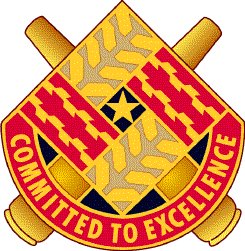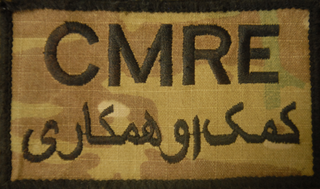The Combat Capabilities Development Command Soldier Center, formerly the United States Army Natick Soldier Research, Development and Engineering Center, is a military research complex and installation in Natick, Massachusetts, charged by the U.S. Department of Defense with the research and development of food, clothing, shelters, airdrop systems, and other servicemember support items for the U.S. military. It is a component unit of the United States Army Combat Capabilities Development Command and is a tenant unit of the United States Army Natick Soldier Systems Center (SSC). The installation includes facilities from all the military services, not just the Army, and is so configured to allow cross-service cooperation and collaboration both within the facility and with the many academic, industrial and governmental institutions in the Greater Boston Area.

The Air Force Materiel Command (AFMC) is a Major Command (MAJCOM) of the United States Air Force (USAF). AFMC was created on July 1, 1992, through the amalgamation of the former Air Force Logistics Command (AFLC) and the former Air Force Systems Command (AFSC).

The United States Army Aviation and Missile Command (AMCOM) develops, acquires, fields and sustains aviation, missile and unmanned aerial vehicles. AMCOM is primarily responsible for lifecycle management of army missile, helicopter, unmanned ground vehicle and unmanned aerial vehicle weapon system. The central part of AMCOM's mission involves ensuring readiness through acquisition and sustainment support for aviation systems, missile systems, and test, measurement, and diagnostic equipment (TMDE) throughout their life cycle. The command is headquartered at Redstone Arsenal in Huntsville, Alabama, has a 2019 "budget of more $3.7 billion, and a global workforce of more than 15,000 military and civilian employees".

The Defense Contract Management Agency (DCMA) is an agency of the United States federal government reporting to the Under Secretary of Defense for Acquisition and Sustainment. It is responsible for administering contracts for the Department of Defense (DoD) and other authorized federal agencies. Its headquarters is located at Fort Gregg-Adams, Virginia. DCMA also administers Foreign Military Sales contracts.

The U.S. Army Combined Arms Support Command (CASCOM) is a major subordinate command of the U.S. Army Training and Doctrine Command (TRADOC) and is located at Fort Gregg-Adams, Virginia. Subordinate to CASCOM is the Sustainment Center of Excellence (SCoE), which oversees and coordinates the five sustainment branches of the Army and the Army Sustainment University. The commander of CASCOM is dual-hatted as the head of SCoE. The CASCOM commander also serves as the commander of Fort Gregg-Adams.
The United States Army Logistics Management College (ALMC) is a forerunner of the Army Sustainment University (ASU) located at Fort Gregg-Adams, Virginia. ASU is a subordinate school of the United States Army Combined Arms Support Command.

The United States Army Tank-automotive and Armaments Command (TACOM), and its subordinate Life Cycle Management Command (LCMC), headquartered at the Detroit Arsenal in Warren, Michigan, is part of the United States Army Materiel Command (AMC).

The U.S. Army Materiel Command (AMC) is the primary provider of materiel to the United States Army. The Command's mission includes the management of installations, as well as maintenance and parts distribution. It was established on 8 May 1962 and was activated on 1 August of that year as a major field command of the U.S. Army. Lieutenant General Frank S. Besson, Jr., who directed the implementation of the Department of Army study that recommended creation of a "materiel development and logistics command", served as its first commander.
The United States Army Medical Research and Development Command (USAMRDC) is the United States Army's medical materiel developer, with responsibility for medical research, development, and acquisition.

The Military Surface Deployment and Distribution Command (SDDC) is the Army Service Component Command of the U.S. Transportation Command (USTRANSCOM) and is a major subordinate command to Army Materiel Command (AMC). This relationship links USTRANSCOM's Joint Deployment and Distribution Enterprise and AMC's Materiel Enterprise. The command also partners with the commercial transportation industry as the coordinating link between DOD surface transportation requirements and the capability industry provides.
The United States Army Medical Materiel Agency (USAMMA), a subordinate unit of the U.S. Army Medical Research and Development Command at Fort Detrick, Maryland, and serves as the U.S. Army's executive agent for strategic medical acquisition and logistics programs.

The United States Army Security Assistance Command (USASAC) – "the 'Army's Face to the World'" - implements security assistance programs, including Foreign Military Sales (FMS) of defense articles and services to eligible foreign governments. In addition, USASAC is responsible for the US Army's security assistance information management and financial policy and provides logistics guidance to the army's security assistance community. The command also supports the U.S. government's emergency assistance, humanitarian relief, and Operations Other Than War, including peacekeeping operations by the United Nations. The USASAC traces its origins to the Army's technical service era, and was designated a major subordinate command (MSC) of the U.S. Army Materiel Command (AMC) in 1975. Since its formation, USASAC has supported major US military operations and supported international peacekeeping and humanitarian efforts. The USASAC's motto is "Strength in Cooperation."

The Logistics Civil Augmentation Program (LOGCAP) is a program administered by the US Army to provide contingency support to augment the Army force structure. The first three contracts were awarded to a single bidder in each round of competition. The fourth and current contract, awarded in June 2007, was split between three companies with each company having the opportunity to compete for task orders.

The Communications-Electronics Command (CECOM) is a Life Cycle Management Command (LCMC) of the United States Army based at Aberdeen Proving Ground, Maryland, United States. It is one of four such commands under the Army Materiel Command (AMC), and is the Army's provider and maintainer of Command, Control, Communications, Computers, Cyber, Intelligence, Surveillance and Reconnaissance (C5ISR) capabilities.

The United States Army Sustainment University is the Army's center of sustainment training for Department of Defense military and civilian personnel pursuing Professional Military Education (PME) and other associated training in military logistics and sustainment. The Army Sustainment University (ASU) has two campuses. The Somervell Campus at Fort Gregg-Adams, Virginia, delivers sustainment leader education for Quartermaster, Ordnance, and Transportation Soldiers and civilians. The Adams Campus at Fort Jackson, South Carolina, includes the Soldier Support Institute, which delivers Adjutant General and Financial Management leader education. ASU is a subordinate command to the United States Army Combined Arms Support Command, and is located at Fort Gregg-Adams, Virginia. The current President of Army Sustainment University is Ms. Sydney A. Smith, Senior Executive Service.

The 12th Port of Embarkation, later designated 377th Theater Sustainment Command, was constituted on 2 July 1942 and was activated 5 July 1942 at Fort Dix, New Jersey. The unit was converted, reorganized, and redesignated 7 November 1942 as the 12th Port. The unit was inactivated 4 January 1946 at Camp Kilmer, New Jersey and later redesignated 3 November 1948 in New Orleans, Louisiana, as the 377th Transportation Major Port. On 11 September 1950 the 377th was called to Camp Kilmer, New Jersey. Later, the unit moved to Fort Eustis, Virginia and stayed on active Federal Service until 10 October 1952. From 1953 until 1963, the 377th remained in a Reserve status and experienced several changes in unit designation.

CENTCOM Materiel Recovery Element (CMRE) is a military organization tasked with conducting materiel reduction and engineer deconstruction operations in Afghanistan for the purpose of saving valuable military equipment and returning operating bases to local land owners, the Afghan Local Police (ALP), or the Afghan National Army (ANA).

The United States Army Sustainment Command (ASC) is the primary provider of logistics support to units of the United States Army. It is a major subordinate command of United States Army Materiel Command (AMC).

403d Army Field Support Brigade (AFSB), headquartered at Camp Henry, Daegu, Republic of Korea, delivers U.S. Army Materiel Enterprise to supported forces throughout the Korean and Japanese Theaters of Operations.

Gustave F. Perna is a retired United States Army four-star general who last served as the chief operating officer of the federal COVID-19 response for vaccine and therapeutics. He previously served as the chief operating officer of Operation Warp Speed from July 2020 until the operation's duties and responsibilities were transferred to the White House COVID-19 Response Team in February 2021. As chief operating officer of COVID-19 response, he oversaw the logistics in the United States federal government's distribution of the vaccine to the COVID-19 pandemic. The Senate confirmed his nomination as chief operating officer on July 2, 2020, and he assumed the office shortly after.


















